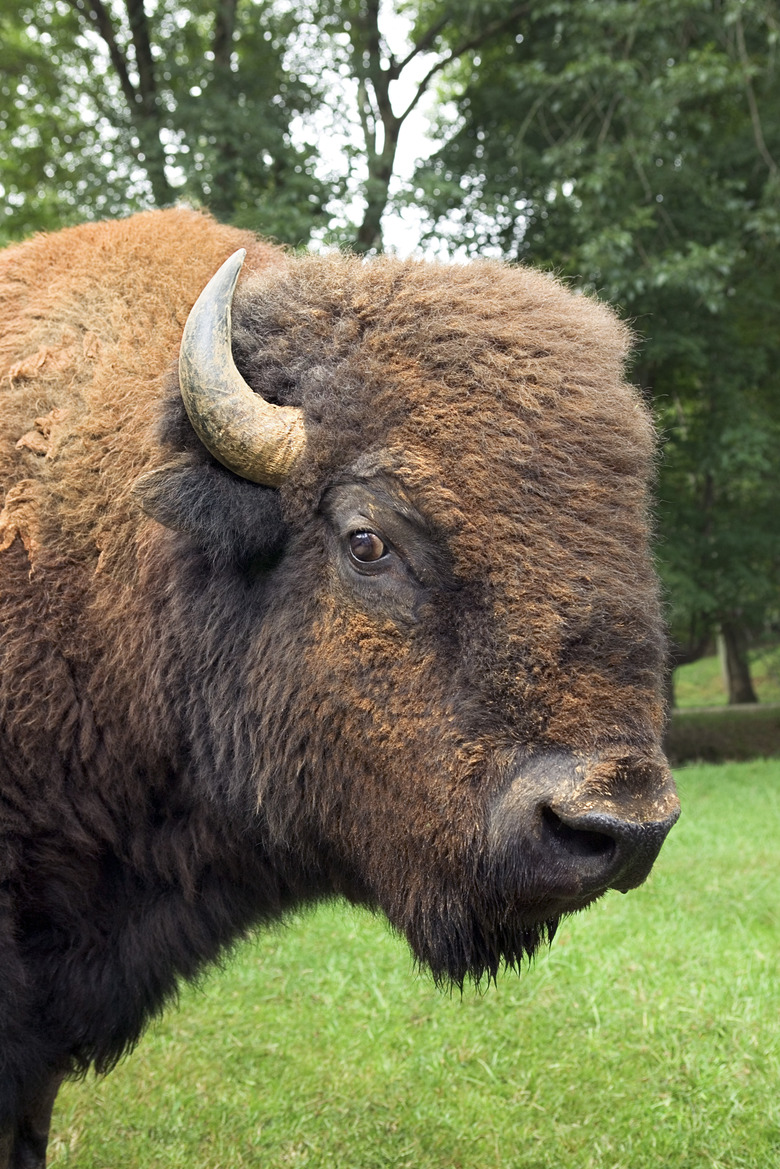Endangered Species In The European Deciduous Forest
Once upon a time, the European continent was covered with dense deciduous forests that provided suitable habitat for many animal species. Human development whittled away at these forests to the point that little of the forest remains in Europe. As a result, many species have lost their habitats and became vulnerable to dangers such as pollution and pesticides. The destruction of these forests, not to mention the intrusion into what's left of them, has reduced the breeding populations of a number of forest-dwelling animals, notably the European bison and the European mink.
European Bison
Similar in appearance to the American buffalo, the European bison, also known as the wisent, is a bit smaller and not quite as shaggy as his American cousin. Prior to the 20th century, these bison roamed freely throughout southeastern, central and western Europe; but by 1927, wild bison had become extinct in the wild thanks to hunting and habitat loss caused by agricultural development, with only 54 captive members of the species surviving in zoos throughout Europe. Since then, conservation efforts and reintroduction of the beasts to areas where they once ranged have helped the species to bounce back significantly, although it is still classified as "Vulnerable" on the International Union for Conservation of Nature's Red List of Threatened Species.
European Mink
One of the most critically endangered of Europe's forest animals, the European mink is another species that became nearly extinct thanks to both hunting and habitat loss. Where this long, slender member of the mustelid family was once found throughout all of Europe, today the wild population is known to exist in small numbers in some parts of eastern Europe, Spain and France. Like his American cousin, this mink was once a major target of the fur trade, but hunting of this species has been banned. Nevertheless, the mink faces other threats, including pollution, pesticide poisoning, loss of habitation due to human development, and competition for food and habitat from the American mink, which was transplanted to Europe in the 1920s.
Common Otter
The common otter, also known as the European or Eurasian otter, is listed as "Near Threatened" on the IUCN Red List. Another member of the mustelid family, this sleek aquatic mammal could once be found throughout the United Kingdom as well as most of Europe and Asia. However, the creature's population has declined rapidly since the mid-20th century, and in Great Britain the creature can now be found only in Wales, Scotland, Northern Ireland and southwestern parts of England. Like the mink, the otter was once a target of the fur trade. Although the hunting and trapping of otters has been banned throughout Europe, the population also suffers from pollution and a lack of river vegetation suitable for concealing their holts or dens. Conservation and repopulation efforts have included planting more vegetation in rivers and constructing artificial holts.
Greater Spotted Eagle
A migratory bird of prey found in fragmented breeding populations in the deciduous forests of Eastern Europe, mainland China and Mongolia, the greater spotted eagle is listed as "Vulnerable" on the IUCN Red List. Despite the name, only juvenile eagles have white spots on their otherwise dark feathers, which fade as they reach adulthood. This bird population faces a wide variety of threats, including habitat destruction due to drainage of wetlands, and both urban and agricultural development. Although this is a legally protected species in many European countries, it is also the victim of shooting as well as deliberate and accidental poisoning. This species has become diluted through crossbreeding with the lesser spotted eagle, which may be the result of an inability to find a mate within its own species. The introduction of the American mink to Europe has also created competition with the greater spotted eagle for food.
Cite This Article
MLA
Bauhaus, Jean Marie. "Endangered Species In The European Deciduous Forest" sciencing.com, https://www.sciencing.com/endangered-species-european-deciduous-forest-8711/. 24 April 2017.
APA
Bauhaus, Jean Marie. (2017, April 24). Endangered Species In The European Deciduous Forest. sciencing.com. Retrieved from https://www.sciencing.com/endangered-species-european-deciduous-forest-8711/
Chicago
Bauhaus, Jean Marie. Endangered Species In The European Deciduous Forest last modified March 24, 2022. https://www.sciencing.com/endangered-species-european-deciduous-forest-8711/
